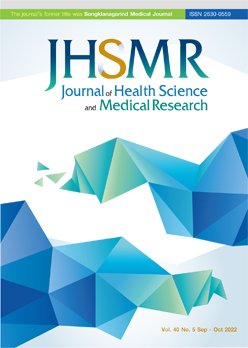The Stability of Gold Nanoparticles-Prussian Blue Based Sensors for Biosensor Applications in Clinical Diagnosis
Keywords:
biosensor, electrochemical stability, gold nanoparticles, pH effect, point-of-care testingAbstract
Objective: Many medical biosensors have been widely developed for use in clinical diagnosis as point-of-care testing. However, most of them still suffer from inaccurate results, caused by the lack of biosensor stability under variable pH of biofluid samples; such as urine. Hence, the instability of pH variations is one of the key challenges for electrochemical biosensors. In this study, the development of gold nanoparticles-Prussian blue (AuNPs-PB) based screen-printed electrodes were investigated for their performance, in terms of electrochemical stability within various pH solutions.
Material and Methods: The AuNPs-PB modified screen-printed gold electrode (SPAuE) was developed and optimized using an electrode-position technique and cyclic voltammetry, respectively. As compared to PB modified SPAuE, the signal response of cyclic voltammograms at AuNPs-PB modified SPAuE was examined in a phosphate buffer solution with different pH values. The electrochemical stability of the modified SPAuE was considered on the invariability of the PB redox current in different pH solutions.
Results: The result revealed that stable current signals of PB in different pH solutions of the AuNPs-PB modified SPAuE showed good electrochemical stability, with a relative standard deviation (RSD) of oxidation and reduction peak currents being 1.0% and 1.1%, respectively. The signal stability results exhibited over two and five times when compared to those of the PB modified SPAuE (without gold nanoparticles), which were 2.4% and 5.6% RSD, respectively.
Conclusion: The AuNPs-PB modified SPAuE provides a potentially alternative tool for the enhancement of electrochemical stability for use in medical biosensor applications.
References
Thévenot DR, Toth K, Durst RA, Wilson GS. Electrochemical biosensors: recommended definitions and classification. Biosens Bioelectron 2001;16:121–31.
Vinoth S, Shalini Devi KS, Pandikumar A. A comprehensive review on graphitic carbon nitride based electrochemical and biosensors for environmental and healthcare applications. TrAC - Trends Anal Chem 2021;140:116274.
Yang A, Yan F. Flexible electrochemical biosensors for health monitoring. ACS Appl Electron Mater 2021;3:53–67.
Lee SX, Lim HN, Ibrahim I, Jamil A, Pandikumar A, Huang NM. Horseradish peroxidase-labeled silver/reduced graphene oxide thin film-modified screen-printed electrode for detection of carcinoembryonic antigen. Biosens Bioelectron 2017;89: 673–80.
Clarkson MR, Magee CN, Brenner BM. Laboratory assessment of kidney disease. In: Clarkson MR, Magee CN, Brenner BM, editors. Pocket companion to Brenner and Rector’s the kidney. 8th ed. London: Elsevier; 2011;p.21–41.
Chan KF, Lim HN, Shams N, Jayabal S, Pandikumar A, Huang NM. Fabrication of graphene/gold-modified screen-printed electrode for detection of carcinoembryonic antigen. Mater Sci Eng C 2016;58:666–74.
Wei S, Xiao H, Cao L, Chen Z. A label-free immunosensor based on graphene oxide/Fe3O4/Prussian blue nanocomposites for the electrochemical determination of HBsAg. Biosensors 2020;10. doi: 10.3390/bios10030024.
Wu X, Cao M, Hu C, He X. Sonochemical synthesis of Prussian blue nanocubes from a single-source precursor. Cryst Growth Des 2006;6:26–8.
Zhang M, Hou C, Halder A, Ulstrup J, Chi Q. Interlocked graphene–Prussian blue hybrid composites enable multifunctional electrochemical applications. Biosens Bioelectron 2017;89:570–7.
Keihan AH, Ramezani Karimi R, Sajjadi S. Wide dynamic range and ultrasensitive detection of hydrogen peroxide based on beneficial role of gold nanoparticles on the electrochemical properties of prussian blue. J Electroanal Chem 2020;862: 114001.
Haji-Hashemi H, Habibi MM, Safarnejad MR, Norouzi P, Ganjali MR. Label-free electrochemical immunosensor based on electrodeposited Prussian blue and gold nanoparticles for sensitive detection of citrus bacterial canker disease. Sensors Actuators, B Chem 2018;275:61–8.
Baggio BF, Vicente C, Pelegrini S, Cid CCP, Brandt IS, Tumelero MA, et al. Morphology and structure of electrodeposited Prussian Blue and Prussian white thin films. Materials (Basel) 2019;12:15–21.
Zhao J, Yue P, Tricard S, Pang T, Yang Y, Fang J. Prussian blue (PB)/carbon nanopolyhedra/polypyrrole composite as electrode: a high performance sensor to detect hydrazine with long linear range. Sensors Actuators, B Chem 2017;251:706–12.
Ricci F, Amine A, Palleschi G, Moscone D. Prussian Blue based screen printed biosensors with improved characteristics of long-term lifetime and pH stability. Biosens Bioelectron 2002; 18:165–74.
Li Z, Chen J, Li W, Chen K, Nie L, Yao S. Improved electrochemical properties of prussian blue by multi-walled carbon nanotubes. J Electroanal Chem 2007;603:59–66.
Husmann S, Orth ES, Zarbin AJG. A multi-technique approach towards the mechanistic investigation of the electrodeposition of Prussian blue over carbon nanotubes film. Electrochim Acta 2019;312:380–91.
Saha K, Agasti SS, Kim C, Li X, Rotello VM. Gold nanoparticles in chemical and biological sensing. Chem Rev 2012;112:2739– 79.
Kumar SS, Joseph J, Phani KL. Novel method for deposition of gold-prussian blue nanocomposite films induced by electro chemically formed gold nanoparticles: characterization and application to electrocatalysis. Chem Mater 2007;19:4722–30.
Wang G, Chen L, Zhu Y, He X, Xu G, Zhang X. Prussian blue–Au nanocomposites actuated hemin/G-quadruplexes catalysis for amplified detection of DNA, Hg2+ and adenosine triphosphate. Analyst 2014;139:5297–303.
Arduini F, Micheli L, Moscone D, Palleschi G, Piermarini S, Ricci F, et al. Electrochemical biosensors based on nanomodified screen-printed electrodes: recent applications in clinical analysis. TrAC - Trends Anal Chem 2016;79:114–26.
Ahmed MU, Hossain MM, Safavieh M, Wong YL, Rahman IA, Zourob M, et al. Toward the development of smart and low cost point-of-care biosensors based on screen printed electrodes. Crit Rev Biotechnol 2016;36:495–505.
Salazar P, Martín M, González-Mora JL, González-Elipe AR. Application of Prussian Blue electrodes for amperometric detection of free chlorine in water samples using Flow Injection Analysis. Talanta 2016;146:410–6.
McNamara J, Worthley LI. Acid-base balance: part I. Physiology. Crit Care Resusc 2001;3:181–7.
Lee Hamm L, Simon EE. Roles and mechanisms of urinary buffer excretion. Am J Physiol - Ren Fluid Electrolyte Physiol 1987;253:595–605.
Isfahani VB, Dizaji, Hamid Rezagholipour Memarian N, Arab A. Electrodeposition of Prussian Blue films: study of deposition time effect on electrochemical properties. Mater Res Express 2019;27:096449.
Wang J. Analytical electrochemistry. 2nd ed. New York: Wiley-VCH; 2000;p.223.
Karyakin AA. Prussian blue and its analogues: electrochemistry and analytical applications. Electroanalysis 2001;13:831–5.
Downloads
Published
How to Cite
Issue
Section
License

This work is licensed under a Creative Commons Attribution-NonCommercial-NoDerivatives 4.0 International License.




















